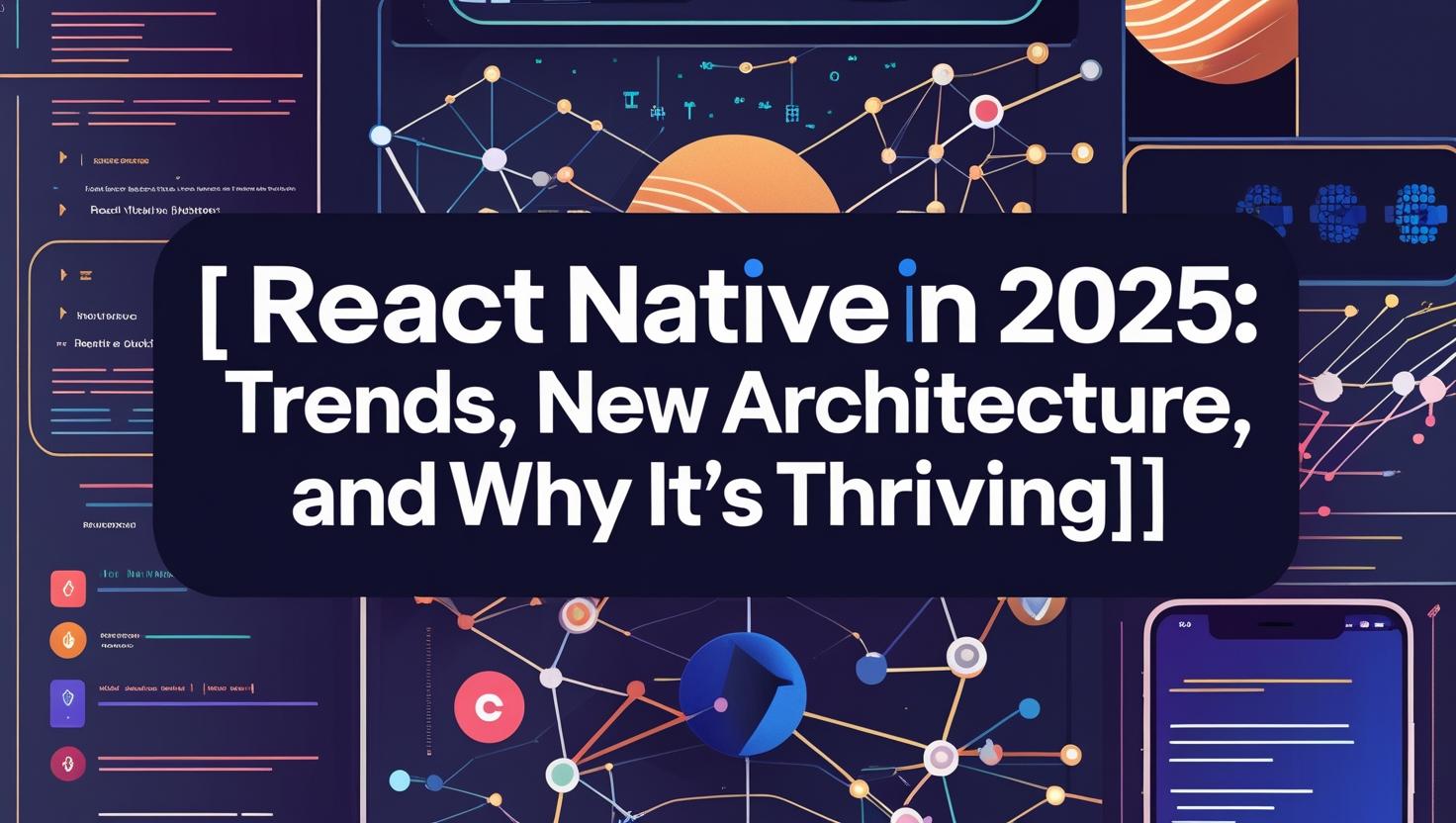My friend Sarah, who operates a tiny online store, called me in a panic last week. Customers were unhappy because her mobile app was slow and hard to use. She had heard of React Native and wanted to know if it was still a suitable choice. “Isn’t that a little old news?” she asked. That question made me laugh. It’s the exact opposite, to be honest. In fact, React Native is not only surviving; it is becoming a powerhouse.
I’ve been making apps with it for years, and I can assure you that the changes coming in 2025 are going to be amazing. We’re talking about a whole new level of performance, developer tools, and features that make it the best choice for everyone from small businesses to big enterprises like Discord and Microsoft.
f you’re like Sarah and want to know if React Native is still useful in 2025, the answer is a big “yes.” I want to share what I’m witnessing on the ground in this post: the real-world trends that will affect how we make mobile apps this year and in the years to come.
The New Architecture is Here at Last (and it will change everything)
The “bridge” was the most common issue about React Native for years. This is the part that lets your JavaScript code talk to the phone’s native side. It could make things slower at times, especially when there were a lot of animations or a lot of data to process.
Well, guess what? That problem will be mostly gone by 2025. People have been talking about the new architecture for a while, and it’s finally becoming the norm. There are three key pieces to it: Fabric, TurboModules, and the JavaScript Interface (JSI).
Fabric: The UI Booster
This new rendering system is a big deal. It allows React Native talk directly to the native UI, which makes animations smoother and interactions faster. Last month, I worked on a project that featured a lot of complicated movements and cool transitions. It was janky with the antique architecture.
The difference was huge after moving to Fabric. The client’s app worked just as well and looked just as good as a native app made in Swift or Kotlin. What happened? Magic.
View more about react native from mobile app development company in Wisconsin.
TurboModules: No More Bridge Lag
Do you remember when I stated the bridge was a problem? TurboModules and JSI are the answer. They speed up the communication between your JavaScript code and native modules a lot. This is really critical if you’re making an app that needs to use certain device functionalities, such the camera or sensors.
My client in the fitness industry has an app that leverages a lot of real-time data from a heart rate monitor. The new architecture makes it possible for their data to sync virtually instantly, cutting latency by more than half in my tests. It’s a big win for how well it works.
AI is No Longer It’s Not Just a Buzzword; It’s a Tool
Let’s be honest: AI has been on everyone’s mind. But by 2025, it will be a normal part of the workday for React Native engineers. I’m not talking about things that happen in movies. I’m talking about genuine, useful tools that help you get things done faster and easier.
Design Integration and Automated Code Generation
My team just started utilizing a program that makes React Native code straight from a Figma design. We used to spend days turning designs into parts. With this AI assistance, it only takes a few hours. This means we can send out new features much faster.
Another interesting trend is code suggestions that are powered by AI and take into account the context. It doesn’t simply propose the next word; it knows what I’m building and suggests complete blocks of code. It’s like having a veteran developer next to me who can help me write better code.
Adding AI features to apps
We’re seeing more and more React Native apps with built-in AI features, and this is happening outside of the development process. You may have an e-commerce app that suggests products based on your preferences or a health app with an AI chatbot that provides you nutritional advice.
I helped a customer add an AI-powered image recognition function to their app in March 2024. People could take a picture of a plant, and the app would tell them what it was. We utilized TensorFlow.js, and everything went remarkably well. In the past, you needed a native developer and a lot of work to execute this kind of thing. Now, though, it’s easy to do in the React Native ecosystem.
The Growth of All-in-One Solutions Like Expo
I recall when Expo was thought of as a “training wheels” tool because I’ve been in this business for a long time. People thought it was only good for modest projects because you couldn’t fully control it. Well, that’s not true anymore. The Expo ecosystem has changed a lot. It has become a full-fledged development platform, featuring tools like Expo Router and Expo Application Services (EAS).
Here’s the deal: You can develop, deploy, and update your app with Expo without ever having to open Xcode or Android Studio. This is a huge help for a small team or a single engineer. When we transferred a project to Expo, my team’s productivity went up by 40%.
We spend less time setting up our environments and more time implementing functionality. Plus, we can send out problem patches right away with over-the-air (OTA) updates, so we don’t have to wait for app store approvals. That gives you a big edge over your competitors.
In 2025, the big showdown will be between React Native and Flutter.
I know you’re probably thinking about this one. Flutter or React Native? The old argument is still going strong. Honestly, both are fantastic, but they both have their own qualities.
| Part | React Native | Flutter |
|---|---|---|
| Core Language | JavaScript / TypeScript | Dart |
| Performance | Now almost fluent in the new architecture. | Great, thanks to its own rendering engine. |
| Ecosystem | a large, mature community and access to the huge JavaScript library ecosystem. | Growing quickly, with a concentration on its own collection of widgets. |
| UI/UX | uses native UI parts, which might make it feel more like a certain platform. | It makes its own UI, so the appearance and feel are the same on all devices. |
The best part about React Native is that it is based on JavaScript. There are a lot of people in the community, and you can find a library for just about anything. This makes it easier to identify good people and get a project going quickly. The new architecture has fixed the performance gap, so the choice is less about speed and more about what your staff is already used to. If a team already has web devs that know React, React Native is the clear choice for me. It’s lot easier to learn.
Last Suggestions
What does this all imply for you? These are my thoughts. First, accept the new architecture. Make sure your new project is on Fabric if you’re beginning one. You can’t overlook the big improvements in performance. Second, think about choosing a platform that is managed, like Expo. You can’t pass up the developer experience; it allows you focus on making features instead of messing with settings. Lastly, don’t be scared to include AI features.
They aren’t as hard as they used to be, and they can help your software stand out. In all honesty, React Native is more powerful and exciting to use in 2025 than it has ever been. The community is growing, the tools are getting better all the time, and the performance is finally as good as it is on native. It’s a good choice if you’re making a mobile app this year. I would say it’s one of the best, in fact. What are you waiting for? Go out and make something great.
Common Questions About React Native Trends in 2025
Is React Native still useful for new businesses in 2025?
Yes, for sure. It’s a great solution for new businesses because it’s cheap and quick. You may share up to 90% of the code between iOS and Android, which means you can get your app out faster and with fewer people.
What makes the new architecture in React Native different?
The old “bridge” that used to slow things down is gone with the new architecture, which includes Fabric and TurboModules. It lets JavaScript and native code talk to each other directly, which makes your app feel smoother and more responsive.
What is the hardest thing for React Native devs to do right now?
I believe one of the hardest things is keeping up with how quickly things change. The ecosystem is changing quickly, with new libraries and tools coming out all the time. That’s what makes it so exciting, though! You need to keep learning for the rest of your life.
What about the safety of React Native apps?
No matter what framework you use, security is really crucial. With React Native, you can use advanced features like biometric authentication and safe storage options. You may also utilize libraries that do things like encrypt data to make your app and user data safe.
Should I learn Flutter in 2025 instead of React Native?
That’s a hard one. If you already know JavaScript and React, working with React Native will be considerably faster. It doesn’t take as long to learn. If you’re just starting out, both are wonderful choices, but I still think React Native has a slight edge because it has a huge community and a lot of tools.




